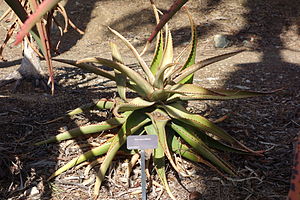Aloe secundiflora
| Aloe secundiflora | ||||||||||||
|---|---|---|---|---|---|---|---|---|---|---|---|---|

Aloe secundiflora |
||||||||||||
| Systematics | ||||||||||||
|
||||||||||||
| Scientific name | ||||||||||||
| Aloe secundiflora | ||||||||||||
| Engl. |
Aloe secundiflora is a species of aloes in the subfamily of the Affodilla plants (Asphodeloideae). The specific epithet secundiflora comes from Latin , means 'one-sided blooming' and refers to the one-sided flowers of the species.
description
Vegetative characteristics
Aloe secundiflora grows without a stem or with a very short stem, is usually simple and occasionally forms small groups. The approximately 20 ovate-lanceolate, narrowed leaves form a dense rosette . The glossy, cloudy green leaf blade is 30 to 75 centimeters long and 8 to 30 centimeters wide. The leaf surface is smooth. The stinging, dark brown teeth on the often horny leaf margin are 3 to 6 millimeters long and 10 to 20 millimeters apart. The leaf juice dries yellow.
Inflorescences and flowers
The inflorescence has ten to twelve branches and reaches a length of 100 to 150 centimeters. The lower branches are branched again. The loose grapes are 15 to 20 centimeters long and consist of single-sided flowers. The egg-shaped, pointed bracts are 3 to 7 millimeters long and 2 to 5 millimeters wide. The pinkish red to cloudy scarlet flowers are lighter at their mouth and are on 5 to 10 millimeter long peduncles . The flowers are 25 to 35 millimeters long and truncated at their base. At the level of the ovary , they have a diameter of 9 millimeters. Above that, the flowers are slightly narrowed and finally slightly expanded towards the mouth. Your tepals are not fused together over a length of 12 to 17 millimeters. The stamens and the pen stand out 3 to 6 millimeters from the flower.
Systematics and distribution
Aloe secundiflora is common in Ethiopia , Sudan , Kenya , Rwanda and Tanzania . The distribution area of Aloe secundiflora var. Secundiflora extends from the south in Ethiopia and south-east in Sudan through Kenya to the north of Tanzania and Rwanda. The variety grows on grassland and open woodland on sandy soil at altitudes of 750 to 1980 meters. Aloe secundiflora var. Sobolifera is widespread in central Tanzania in woodlands on sandy soil at altitudes of 600 to 1825 meters.
The first description by Adolf Engler was published in 1895. A distinction is made between the following varieties :
- Aloe secundiflora var. Secundiflora
- Aloe secundiflora var. Sobolifera S. Carter
Aloe secundiflora subsp. secundiflora
The following taxa were synonymous with the species: Aloe engleri A. Berger (1905), Aloe floramaculata Christian (1940) and Aloe marsabitensis I. Verd . & Christian (1940).
Aloe secundiflora subsp. sobolifera
The differences to Aloe secundiflora var. sobolifera are: The variety sprouts and often forms large groups. The lanceolate, dark green, often bronze-colored leaves are 8 to 15 centimeters (rarely up to 20 centimeters) wide at their base. The marginal teeth that are not pierced are never connected by a horny margin. The first description by Susan Carter was published in 1994.
proof
literature
- Susan Carter , John J. Lavranos , Leonard E. Newton , Colin C. Walker : Aloes. The definitive guide . Kew Publishing, Royal Botanic Gardens, Kew 2011, ISBN 978-1-84246-439-7 , pp. 379-380 .
- Leonard Eric Newton: Aloe secundiflora . In: Urs Eggli (Hrsg.): Succulent lexicon. Monocotyledons . Eugen Ulmer, Stuttgart 2001, ISBN 3-8001-3662-7 , pp. 178-179 .
Individual evidence
- ↑ Gideon F. Smith, Colin C. Walker, Estrela Figueiredo: What's in a name: epithets in Aloe L. (Asphodelaceae) and what to call the next new species . In: Bradleya . Volume 28, 2010, p. 100.
- ↑ Adolf Engler (Ed.): Plant world of East Africa and the neighboring areas . Part C, 1895, p. 140 ( online ).
- ^ Susan Carter: Flora of Tropical East Africa. Aloaceae . 1994, pp. 32-33.
Web links
- Description at Plant Resources of Tropical Africa
- Photos of Aloe secundiflora var. Secundiflora